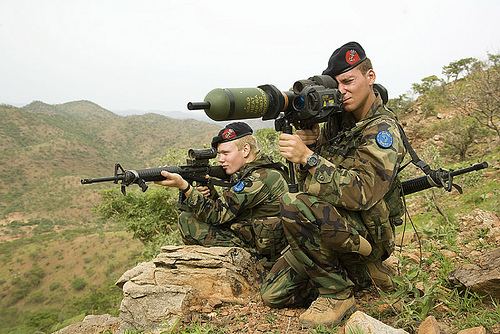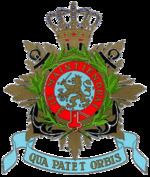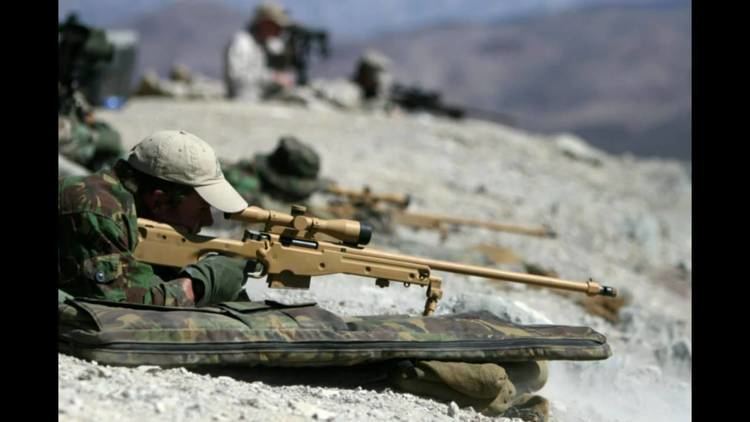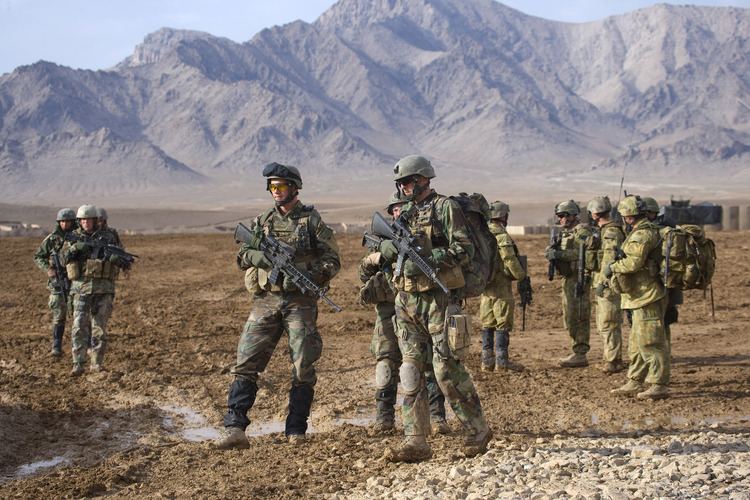Country Netherlands Type Marine Corps | Branch Royal Netherlands Navy Founded 10 December 1665 | |
 | ||
Active 10 December 1665 – present
(351 years, 3 months) Role Expeditionary Force
Rapid Reaction Force
Special Operations Force Size ~ 2,300 (1 Brigade/Regiment) Motto Qua Patet Orbis ("As Far as the World Extends") Allegiance Politics of the Netherlands Founders Michiel de Ruyter, Johan de Witt Engagements Iraq War, Battle of the Java Sea, Rotterdam Blitz Similar Royal Netherlands Navy, Royal Netherlands Army, Royal Marechaussee, Armed forces of the Nethe, Royal Netherlands Air Force | ||
Royal netherlands marine corps 1665 2015
The Korps Mariniers is the marine corps and amphibious infantry component of the Royal Netherlands Navy. The marines are trained to operate anywhere in the world in all environments, under any condition and circumstance, as a rapid reaction force. The Korps Mariniers can be deployed to any location in the world within 48 hours. Their motto is Qua Patet Orbis ("As Far As The World Extends").
Contents
- Royal netherlands marine corps 1665 2015
- Netherlands marine corps
- History
- Modern Korps Mariniers
- Structure
- Netherlands Maritime Force
- Maritime Special Operations Forces
- Surface Assault and Training Group
- Seabased Support Group
- 32nd Raiding Squadron Dutch Caribbean Forces
- Recruitment and Training
- Initial training
- Operational training
- Specialisation
- Armour
- Landingcraft
- Other vehicles
- Weaponry
- United KingdomNetherlands Amphibious Force UKNL AF
- Alliances
- References

Netherlands marine corps
History
The corps was founded on 10 December 1665 during the Second Anglo-Dutch War by the Prime Minister of the Dutch Republic, Johan de Witt, and Admiral Michiel de Ruyter as the Regiment de Marine. Its leader was Willem Joseph van Ghent. The Dutch had successfully used ordinary soldiers in ships at sea in the First Anglo-Dutch War. It was the fifth European Marine unit formed, being preceded by the Spain's Infantería de Armada (1537), the Portuguese Marine Corps (1610), France's Troupes de marine (1622), and the English Royal Marines (1664). Like Britain, the Netherlands has had several periods when its Marines were disbanded. The Netherlands itself was under French occupation or control from 1810 until 1813. A new Marine unit was raised on 20 March 1801 during the time of the Batavian Republic and on 14 August 1806 the Korps Koninklijke Grenadiers van de Marine was raised under King Louis Bonaparte. The modern Korps Mariniers dates from 1814, receiving its current name in 1817.
The battle honours on the Korps Mariniers' colors are:

In 1667, led by van Ghent, then an admiral, and their new commander, the Englishman Colonel Thomas Dolman, the Regiment de Marine played a prominent part in the large Dutch raid, the "Raid on the Medway" on England (10–14 June). The Korps' battle honour "Chatham" is one of the few ever won on British soil by a foreign unit. The July 2nd attack on Landguard fort near Harwich, performed by 1.500 Mariniers after landing at Woodrich was beaten off by the fort's garrison.
The Mariniers also fought in the Franco-Dutch War/Third Anglo-Dutch War. On June 29, 1672, after serving in the naval Battle of Solebay (7 June), two-thirds of the Marines were withdrawn from the fleet and formed into a brigade in order to stiffen the inefficient and largely mercenary army in anticipation of an English invasion. They returned to their ships in time to help stop an English invasion by defeating a combined English and French force at the naval Battle of Kijkduin (Battle of Texel) on 21 August 1673. Led by Gerolf van Isselmuyden, they served in the land battle of Seneffe against the French in 1674.
Dutch support of American independence led to the Fourth Anglo-Dutch War, where the Mariniers served at Dogger Bank.

In 1704, Netherlands Marines were part of a combined English-Dutch force under Prince George of Hesse-Darmstadt that captured Gibraltar and defended it successfully shortly afterwards. They would combine with the British again for the bombardment of Algiers in 1816.

The Korps Mariniers served in some of the operations of the Netherlands in the Dutch East Indies colony. The Netherlands took a slow approach to conquering the entire colony and operations consolidating their rule lasted from the 1850s until shortly before World War I. The battle honors from the Aceh War (1873–1913) and Bali date from this time.

In World War II, a Korps Mariniers unit in Rotterdam preparing to ship out to the Dutch East Indies successfully defended the bridges across the Maas, preventing German paratroopers in the center of the city from rendezvousing with conventional German infantry. The Germans ended the stalemate by bombing Rotterdam. The threat of an attack by marines caused its German captain to scuttle the Antilla in Aruba in 1940.

When the surrender was declared and the Dutch soldiers came out of their positions, the German commander who was expecting a full battalion of men was stunned to see only a few Dutch Marines emerge in their green uniforms. He ordered his men to salute them out of respect for their bravery and determination and labeled them Zwarte duivels (The Black Devils).
Some Mariniers later joined the Princess Irene Brigade to fight against the Germans. They distinguished themselves in combat near the Dutch city of Tilburg in the autumn of 1944.
Starting in 1943, the United States Marine Corps trained and equipped a new brigade, the Mariniersbrigade, of the Korps Mariniers at Camp Lejeune and Camp Davis in North Carolina in preparation for amphibious landings against the Japanese in the Dutch East Indies. The Japanese surrendered before such landings were needed, but the Mariniersbrigade, fully trained and equipped, left North Carolina in six transports in 1945 and fought against the Indonesians in their National Revolution for independence. It was part of the A Division, which was itself commanded by a Korps Mariniers officer. It was disbanded in 1949.
The Dutch kept Western New Guinea after the Indonesian National Revolution and the Korps Mariniers served there until 1962 when it was granted independence. The same year it was invaded and incorporated into Indonesia.
Modern Korps Mariniers
On 11 June 1977, the Unit Interventie Mariniers (Marine Intervention Unit, UIM) of the Dutch Marine Corps stormed a train that was being held hostage since 23 May by armed South Moluccan nationalists in the village of De Punt, in the province of Drenthe. Six Royal Netherlands Air Force F-104 Starfighters buzzed the train as a diversion just before the assault. Six terrorists and two hostages were killed in the storming. The BBE has become the Dutch government's primary counter-terrorism force. (See "Netherlands Maritime Special Operations Forces " below.)
Lately the Marines have been deployed in various operations all over the world.
18 February 1992 – 18 November 1993: United Nations Transitional Authority in Cambodia (UNTAC).
1995–present: Former Yugoslavia, Bosnia, Kosovo.
28 July 2000 – 7 February 2003: United Nations Mission in Ethiopia and Eritrea (UNMEE).
11 January 2002 – July 2010: deployment in Afghanistan.
1 August 2003 – 2004: deployment in Iraq.
18 November 2003 – 19 February 2004: United Nations Mission in Liberia (UNMIL).
2005–2006: United Nations Organization Mission in the democratic Republic of the Congo (MONUC)
The Corps celebrates its birthday each year at the Oostplein (lit., East Square) in Rotterdam, where all fallen (ex) corpsmembers are remembered.
On 29 May 2009, Marco Kroon, a member of the Korps Commandotroepen and a former member of the Netherlands Marine Corps, was awarded the Military William Order, the highest military decoration in The Netherlands.
Structure
All operational units of the Netherlands Marine Corps fall under the Marine Training Command (MTC). A brigade level command element the "Netherlands Maritime Force" (NLMARFOR) is the deployable operational staff Headquarters which is commanded by a Colonel RNLMC. The major combat elements of NLMARFOR are two battalion sized units called "Marine Combat Groups" (formerly known as Marine Battalions). The 1st Marine Combat Group is the main contribution of the Netherlands Marine Corps to the United Kingdom/Netherlands Landing Force (UK/NL LF).
Netherlands Maritime Force
The Netherlands Maritime Force structure is as follows:
Each Marine Combat Group is commanded by a Lieutenant Colonel and fields 726 men, with the Command Staff consisting of 30 men.
The RSTA Squadron is commanded by a Major and consists of 87 men: the RSTA squadron staff acts also as the Joint Fires Cell for its Marine Combat Group coordinating all types of fire support. Each RSTA Sqn fields an Forward Observer Troop with four Fire Support Teams of six men each, an Unmanned Aerial Vehicle System section with AeroVironment RQ-11 Raven UAV's, a Reconnaissance Sniper Troop, a Mortar Troop with L16 81mm mortars and a Low Altitude Air Defense section.
The Raiding Squadrons are commanded by Majors and consist of 108 men. The Raiding Squadrons each field three Raiding Troops with two Raiding Sections of 16 men each per troop.
The Combat Support Squadron consists of 114 men and a besides its staff fields an Assault Engineer Troop, an Anti-Armour Troop and an Armoured All Terrain Vehicle Troop. Each of these three troops fields three identical sections, with each section supporting one Raiding Squadron of the Marine Combat Group. The Assault Engineer Troop also provides Improvised Explosive Device detection capabilities. The Anti-Armour Troop provides direct fire support with Spike Anti-tank guided missiles. The Armoured All Terrain Vehicle Troop provides BV206S and BVS10 armoured all-terrain personnel carriers to lift the three Raiding Squadrons.
The Combat Service Support Squadron fields 171 personnel and provide maintenance, medical and logistic support. Each Combat Service Support Squadron consists of a Workshop Troop, a Transport Troop, an Equipment Support Troop, a Medical Support Troop and a Communication and Information Systems Troop.
Maritime Special Operations Forces
The Netherlands Maritime Special Operations Forces (NLMARSOF) are the Marine Corps elite units. The Maritime Special Operations Forces are divided into three squadrons and a Support Group. The Maritime Counter Terrorism Squadron (M Sqn) consists of two troops and is a special forces unit. The Conventional Squadron (C Sqn) is special operations unit operating mostly at sea, but also used as advance landing force in amphibious operations. C Squadron fields two troops, one specialized in underwater operations and the other trained in mountain warfare. C Squadron can be deployed by submarine, parachute, various underwater transport and snowmobiles. The Training Squadron (T Sqn) trains all men which are part of the Maritime Special Operations Forces. The Special Operations Forces Support Group (SOFSG) provides logistic support and equipment to the Netherlands Maritime Special Operations Forces.
The Maritime Special Operations Forces was created by merging the Mountain Leader Reconnaissance Platoon, the Unit Interventie Mariniers and the frogman (combat divers) platoon. The Maritime SF training takes about 40 weeks, and eligible marines are trained to become long-range reconnaissance/SF operators and maritime counter-terrorism specialists, with emphasis on maritime special operations (special operations conducted in water-rich environments, and conducted from sea to land). Those who wish to specialise for Mountain Leader or 'frogman' can apply for these specialisations following completion of the SF training. NLMARSOF is modelled after the British Special Boat Service.
Surface Assault and Training Group
The Surface Assault and Training Group (SATG) provides the Marine Corps with maritime vessels. The Surface Assault and Training Group consists of 241 men; besides the staff it fields an Amphibious Support Group, a Landing Craft Utility (LCU) Troop, a Landing Craft Vehicle Personnel (LCVP) Troop, a Fast Raiding Interception and Special Forces Craft (FRISC) Squadron, a Landing Craft Control Team Light and a Landing Craft Control Team Heavy. The Amphibious Support Group provides logistical support for the SATG. The LCU Troop fields five Landing Craft Utility with their crews, while the LCVP Troop fields 12 LCVPs with their crews.
The FRISC Squadron fields three troops: a troop with Raiding Crafts for the Marine Combat Groups, a troop with Maritime Counter Terrorism Crafts (MCT) for the Maritime Counter Terrorism Squadron and a troop with Special Operation and Interceptor Crafts for the Conventional Squadron of the Maritime Special Operations Forces. The two Landing Craft Control Teams consist of a staff, a Beach Recce Group, a Beach Control Group and a Heavy Vehicle Group. The Landing Craft Control Team Heavy is equipped with Leopard 1 BARV beach armoured recovery vehicles. Both Beach Recce Groups field a team of divers to clear mines, barriers and other obstacles from landing beaches.
Seabased Support Group
The Seabased Support Group (SSG) fields 98 men and coordinates maritime operational logistic support for Marine units embarked on one the Rotterdam-class amphibious transport docks. The Seabased Support Group fields an Equipment Support Troop, a Weapons and Ammo Troop, a Workshop and Transport Troop and a Communications and Information Systems (CIS) Troop.
32nd Raiding Squadron (Dutch Caribbean Forces)
The 32nd Raiding Squadron (Dutch Caribbean Forces) consists 153 personnel and is stationed in Aruba and is responsible for the defence of the Netherlands Antilles. The 32nd Raiding Squadron falls operationally under the command of the Naval Commander of the Caribbean (CZMCARIB). 32nd Raiding Squadron. is stationed at the Korps Mariniers Barracks Savaneta (Aruba). Marines on Aruba also participate in anti-drug operations. The squadron is commanded by a Major and consists of Headquarters, 3 Raiding troops and the following supporting units a Fast Raiding, Interception and Special Forces Craft (FRISC) troop (with 12 boats), and a combat service support troop for transport, logistics, maintenance and medical care.
Recruitment and Training
The Dutch Marine Corps is the oldest branch of the armed forces of the Netherlands.
There are two career possibilities to become a marine: enlisted marine, and marine officer, depending on the educational background.
Only men are allowed to serve as marines but many female navy personnel are attached to marine corps units as cooks, administrators, nurses or medical officers.
Initial training
Initial training to become an enlisted marine in the Netherlands lasts about 33 weeks (8 months – roughly equivalent to that of the British Royal Marines). It is given at the Mariniers Opleidingscentrum (M.O.C.) at the Van Ghentkazerne in Rotterdam. It is rigorous and very demanding, both physically and mentally, and eventually 33% to 50% will pass. If successfully completed, the recruits receive their "dark blue beret", and will be assigned to the operational units of Mariniers Training Command (MTC).
Initial training to become a marine officer in the Netherlands lasts a total of 18 months, starting with an intensive 11 months of practical marine officer's training, regarded as the most demanding initial military training within the Dutch armed forces (POTOM – Praktische Opleiding tot Officier der Mariniers). This part of the initial training programme is modular, which means that it is made up of 3 phases. First, the prospective officers will learn the basic skills of every enlisted marine, which takes about 10 weeks. After phase one comes the second phase, commanding a squad of 8 marines. This module lasts for 8 weeks, and emphasizes nightly operations. After successfully completing the second phase comes the final phase of commanding a Troop of marines. This last module is the longest, and cross-training is given by both the Dutch Marine training cadre and that of the British Royal Marines. When successfully completed the 'POTOM', it is followed by a half-year general officer's training at the Koninklijk Instituut voor de Marine (Royal Dutch Naval Academy). If this is finished, the (now) marine officer will be assigned to the operational units of the Mariniers Training Command (MTC).
Operational training
All Dutch marines are trained to operate in any environment, under any condition and circumstance. Therefore, Dutch marines regularly train in arctic, jungle, desert, high-altitude and urban conditions. Throughout their service, the marines embark on various training missions throughout the world. Amphibious warfare forms the heart of the marine corps, and this aspect is already implemented in the initial military training program. During operational training, there is more emphasis on various other tactics in amphibious warfare.
Specialisation
Experienced marines are able to obtain various specialisations. It is common for marines to have multiple specialisations. Popular specialisations include:
Some of these specialisations require the rank of Corporal before being able to follow specialisation training, and must not exceed a maximum age.
Armour
Landingcraft
Other vehicles
Weaponry
Small arms
Sniper rifles
Support/ remaining
United Kingdom/Netherlands Amphibious Force (UK/NL AF)
Since 1972, units of the Netherlands Marine Corps have formed part of the British 3 Commando Brigade during exercises and real conflict situations. Also Mountain Warfare /Force Reconnaissance Troop of C Squadron NLMARSOF will be placed under UK operational command as part of C Squadron, UK Special Boat Service. Together, these form the UK/NL AF. Either the First or the Second Marine Combat Group can be assigned as the Dutch contribution to this force. UK/NL AF contributes to the European Multinational Maritime Force (EMMF).
The cooperation between the Korps Mariniers and the Royal Marines has led to extensive integration in the areas of operations, logistics and materials. Within NATO this is seen as a prime example of what can be achieved in military integration.
The NLMC and Royal Marines have a long history of cooperation. During combined actions by the British and Dutch navies during the War of the Spanish Succession (1702–1713), amphibious operations were carried out, the most notable being the Capture of Gibraltar in 1704. During this action, a successful attack was carried out against the fortress of Gibraltar by an 1800-strong brigade of Dutch and British Marines under the command of Prince George of Hesse-Darmstadt. Both corps share this battle honour.
The British and Dutch armed forces share close relations. The Royal Marines and Netherlands Marine Corps are allied through a 'Bond of friendship'.
The nickname of the Dutch Marines among their British Royal Marine counterparts is "Cloggies," due to the stereotype that most or all Dutch wear clogs, instead of "normal" footwear.
